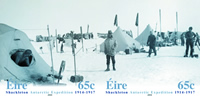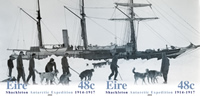
The Religious Society of Friends (Quakers) in Ireland
Quakers in Action
"…faith without works is dead.." James 2.17
Travellers
What do you do when you realise that one section of the community is being treated unfairly by the rest? In 1965 Victor Bewley felt led to do his best to change people's negative attitude to travellers – he did not call them itinerants or tinkers as this implied disrespect. Although he was managing director of Bewley's cafes he devoted time and energy unstintingly to travellers' problems for many years, becoming secretary to the Dublin Committee for Travelling People and then chairman of the National Council. He also put his faith into practice by providing sites for travellers on his small farm. His efforts had a major impact.

Victor Bewley
The Famine
Quakers are remembered for what they did after the potato crop in Ireland failed in 1846 for the second year running. When they realised the seriousness of the famine, straight away they formed a committee to give help. The joint secretaries were Joseph Bewley and Jonathan Pim. Funds, food and clothing were sought from Quakers in England and America.

Quaker Tapestry Scheme©
Visits were made to the areas in most need, mainly in the west, where the potato had become virtually the only food of most of the population. Food was distributed to the needy, whatever their religion, with no strings attached. Soup kitchens were set up in towns and huge quantities were provided – you will see a small plaque in the wall of Monkstown Meeting House where it was dispensed.
In today's money the assistance given was about euro14m, much of which came from Friends in other countries, and Friends also expended a huge amount of their own time and energy. At that time there were about 3,000 Friends in Ireland out of a population of 8.5m. During and after the famine large quantities of seeds for other food crops were distributed and grants were made to fishermen to repair and replace boats and nets. Agricultural training was also provided, and a model farm was established in Co. Galway.
Having decided that he should do what he could to give people the means of avoiding famine in the future James Ellis, a Quaker businessman from Bradford, retired early in 1849 and moved to Letterfrack in Co Galway, where he and his wife Mary used their resources to provide employment and training to scores of men and give schooling to their children. Some of the buildings still exist, and when you visit Letterfrack you will still find much evidence of what they did there.
1798
The insurrection in 1798 was particularly fierce in Co Wexford and in midland counties. There were significant numbers of Quakers in those areas. They did what they could to dissuade both sides from fighting, but are best remembered for their policy of having no guns themselves, tending the wounded of both sides equally, and not refusing food and shelter to either side, thus trying to give a good example of how to treat your fellow man.
Two World Wars
In World Wars I and II Quakers formed the Friends Ambulance Unit (FAU). Their form of service was to save lives and tend the wounded. Some Irish Friends that served in the FAU are still alive and well.
Ireland 1913-1923
There is scope for research into the role of Friends in the turbulent decade which led towards an independent Irish State. One active participant was James G Douglas; we are open to suggestions relating to others; for example the actions of JN Richardson in Bessbrook in 1913, in relation to the processes leading to the Larne gun-running.
Polar Exploration
Ernest (later Sir Ernest) Henry Shackleton was born in Kilkea, Co. Kildare on 15th February 1874. He was a descendant of Abraham Shackleton, a Quaker, who settled in nearby Ballitore in 1725. Shackleton's family moved to England in 1874 and he later joined the Merchant Navy.He made his first of four trips to the Antarctic as a member of Scott's 1901-3 "Discovery" expedition. In 1907-9 he led his own "Nimrod" expedition and reached within 100 miles of the South Pole. In 1914 he set out again for the Antarctic in "Endurance" with the intention of making a Trans-Antarctic crossing. However "Endurance" was crushed in the ice and an epic adventure began to reach safety. The whole party journeyed by foot on ice and in three of the ships' lifeboats by water to Elephant Island, then four crossed 800 miles of storm tossed ocean in a small boat to South Georgia to get help. It was nine months before all the men were rescued.
 ...
...

These stamps commemorate the Shackleton Antarctic voyage. See also enlarged versions of the camp and the ship.
Shackleton set out again in 1921 in "Quest" to circumnavigate the Antarctic but on 5th January 1922 he died on board the ship while it was moored in Grytviken, South Georgia. He is buried there in the Whalers Cemetery.
NB The words 'Friend' and 'Quaker' are interchangeable.